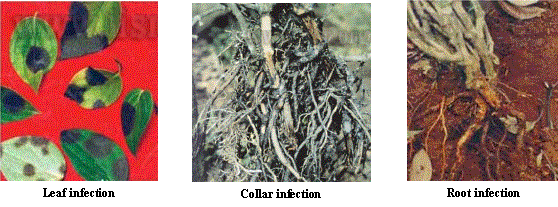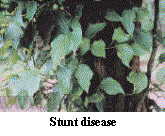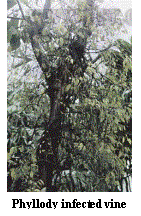|
Diseases in the Main Field
Foot rot disease
Foot rot (quick wilt disease) caused by Phytophthora capsici occurs mainly during
the southwest monsoon season. All parts of the vine are vulnerable to the disease
and the expression of symptoms depend upon the site or plant part infected and the
extent of damage.
Symptoms:
One or more black spots appear on the leaves, which have a characteristic fine fibre
like projections at the advancing margins, which rapidly enlarge and cause defoliation.
The tender leaves and succulent shoot tips of freshly emerging runner shoots trailing
on the soil turn black when infected. The disease spreads to the entire vine
from these infected runner shoots and leaves, during intermittent showers due to
rain splash.

If the main stem at the ground level or the collar is damaged, the entire vine wilts
followed by shedding of leaves and spikes with or without black spots. The
branches break up at nodes and the entire vine collapses within a month.
If the damage is confined to the feeder roots, the expression of symptoms is delayed
till the cessation of rain and the vine starts showing declining symptoms such as
yellowing, wilting, defoliation and drying up of a part of the vine. This may occur
during October-November onwards. These vines may recover after the rains and survive
for more than two seasons till the root infection culminates in collar rot and death
of the vine.
Management:
The disease can be controlled by adopting integrated disease management strategies.
- Phytosanitation:
All infected or dead vines along the root system are to be removed and burnt. Wherever
water stagnation is a problem, effective drainage of both surface and sub-soil is
to be ensured. To avoid soil splash and consequent disease initiation and spread,
a legume cover in the plantation should be ensured. Runner shoots are to be pruned
or tied back to vines before the onset of monsoon. At the onset of monsoon, the
branches of support trees may be lopped off to allow penetration of sunlight and
avoid build up of humidity.
Apply 1 kg lime and 2 kg neem cake per standard per year as pre-monsoon dose. The
application of neem cake should be four weeks after lime application.
- Chemical control:
For the control of Phytophthora foot rot, any of the following control measures
can be adopted.
After the receipt of monsoon showers (May-June), all the vines are to be drenched
over a radius 45-50 cm with 0.2 % copper oxychloride at the rate of 5-10 litres
per vine. This varies according to the age of the plant. A foliar spray with 1%
Bordeaux mixture is also to be given. Drenching and spraying are to be repeated
just before the northeast monsoon. A third round of drenching may be given during
October if the monsoon is prolonged.
After the receipt of a few monsoon showers (May-June), all the vines are to be drenched
over a radius of 45-50 cm with 0.12% potassium phosphonate at the rate of 5-10 litres
per vine. This varies according to the age of the plant. A foliar spray with 0.3%
potassium phosphonate is also to be given. A second drenching and spraying with
0.3% potassium phosphonate is to be repeated just before the northeast monsoon.
If the monsoon is prolonged, a third round of drenching may be given during October.
- Bio-control:
Inoculate pepper vines with native arbuscular mycorrhizal fungi, Trichoderma
and Pseudomonas fluorescens at the time of planting in the nursery and
field, and apply during the pre-monsoon period in the established plantations to
control foot rot. In the field, apply the biocontrol agents around the base of the
vine
Note:(1) All chemical control measures are prophylactic in nature and application
of chemicals in advanced stages of disease will not be effective in combating the
disease, (2) In Phytophthora sick fields, use only chemical control measures.
- Replanting / Rejuvenation:
Total replanting has to be undertaken in gardens where the mortality is 50-60% or
above. Where the mortality is below 50%, timely plant protection measures as described
above should be given to all the existing vines as prophylactic measure and gaps
filled up. Gap filling or replanting should be taken up only after a period of one
year. At the time of replanting, soil drenching with Bordeaux mixture or copper
oxychloride should be given. While replanting, farmers should be encouraged to use
recommended varieties.
Pollu disease (Anthracnose)
This disease is caused by Colletotrichum gloeosporioides and can be distinguished
from the pollu (hollow berry) caused by the beetle by the presence of characteristic
cracks on the infected berries. The disease appears towards the end of the monsoon.
The affected berries show brown sunken patches during early stages and their further
development is affected. In later stages, the discolouration gradually increases
and the berries show the characteristic cross splitting. Finally, the berries turn
black and dry. The fungus also causes angular to irregular brownish lesions with
a chlorotic halo on the leaves.
Management:
For the control of fungal pollu or anthracnose caused by Colletotrichum gloeosporioides,
spray 1% Bordeaux mixture, once before flowering starts (late June and early July)
and then at berry formation stage (late August). Minimize shade in the garden.
Foliar spray of carbendazim @ 1g/l or a formulation containing combination of carbendazim
+ mancozeb @ 1g/l during the month of June can effectively control the disease.
Wherever Phytophthora foot rot management is undertaken properly, separate
control measures for pollu disease may not be necessary.
Note: Since Bordeaux mixture application for pepper is to be given mostly at a time
when the monsoon is very active; it is to be ensured that a sticker is added to
the fungicide. The cheapest and most effective sticker is rosin washing soda mixture.
(1) Preparation of Bordeaux mixture (1%)
Dissolve 1 kg of powdered copper sulphate crystals in 50 litres of water. In another
50 litres of water, prepare milk of lime with 1 kg of quick lime. Pour the copper
sulphate solution into the milk of lime slowly stirring the mixture all the while.
Test the mixture before use for the presence of free copper, which is harmful to
the plants, by dipping a polished knife in it. If the blade shows a reddish colour
due to the deposits of copper, add more lime till the blade is not stained on dipping.
Always use wooden, earthen or copper vessels for the preparation of Bordeaux mixture.
Preparation of sticker rosin washing soda mixture: In order to confer sticking qualities
to Bordeaux mixture, rosin washing soda mixture, may be added. The addition of the
sticker is particularly recommended for sprayings conducted during rainy season.
For preparing the mixture, 10 litres of water out of 100 litres required for preparing
Bordeaux mixture may be kept apart. Boil 10 litres of water, preferably in an earthen
pot and add 500 g of good quality washing soda (sodium carbonate). Boil again until
the solution becomes slightly dark in colour. Add 1 kg of powdered rosin (arpoos)
in the boiling washing soda solution. Reduce the flame for avoiding frothing, foaming
and spilling over. Boil the solution for 5-10 minutes till black bubbles appear.
Cool the solution until the temperature reaches below 45ºC. The cooled mixture
(10 litres) is then added slowly to the prepared Bordeaux mixture (90 litres) under
vigorous stirring.
Spike shedding
Spike shedding especially in varieties like Panniyur-1, at higher elevations like
Kodagu and Idukki is one of the emerging serious diseases. It is seen in serious
condition when the pre-monsoon showers are delayed and flowering and spiking occur
during June-July. These spikes predominantly produce female flowers instead of bisexual
flowers. Heavy spike shedding may occur due to lack of pollination.
Management:
Irrigation of vines from second fortnight of March coupled with prophylactic spraying
with Bordeaux mixture 1 % or carbendazim 0.2% reduces the intensity of spike shedding.
Stunt disease

This disease is caused by viruses. The vines exhibit shortening of internodes
to varying degrees. The leaves become small and narrow with varying degrees
of deformation and appear leathery, puckered and crinkled. Chlorotic spots
and streaks also appear on the leaves occasionally. The yield of the affected
vines decrease gradually.
Two viruses namely, Cucumber mosaic virus and a Badnavirus are associated with the
disease. The major means of spread of the virus is through the use of infected stem
cuttings. The disease can also be transmitted through insects like aphids and mealybugs.
Management:
Use virus free healthy planting material
Regular inspection and removal of infected plants; the removed plants may be burnt
or buried deep in soil
Insects such as aphids and mealybugs on the plants or standards should be controlled
with insecticide spray such as dimethoate at 0.05%.
Phyllody disease
 This disease is caused
by phytoplasma. The affected vines exhibit varying stages of malformation
of spikes. Some of the floral buds are transformed into narrow leaf like structures.
Such malformed spikes show leafy structures instead of floral buds, exhibiting phyllody
symptoms. In advanced stages, the leaves become small and chlorotic, and the
internodes are also shortened. The affected fruiting laterals give a witches
broom appearance. Severely affected vines become unproductive. In severely
affected vines the entire spike is converted into small branches, which appear chlorotic,
and the vines decline rapidly. The infected vine becomes unproductive within
2 to 3 years. This disease is caused
by phytoplasma. The affected vines exhibit varying stages of malformation
of spikes. Some of the floral buds are transformed into narrow leaf like structures.
Such malformed spikes show leafy structures instead of floral buds, exhibiting phyllody
symptoms. In advanced stages, the leaves become small and chlorotic, and the
internodes are also shortened. The affected fruiting laterals give a witches
broom appearance. Severely affected vines become unproductive. In severely
affected vines the entire spike is converted into small branches, which appear chlorotic,
and the vines decline rapidly. The infected vine becomes unproductive within
2 to 3 years.
Management:
The infected vines are to be destroyed to prevent the further spread of the disease.
Planting material should not be collected from such vines.
Slow decline (slow wilt)
Occurrence and symptoms:
Foliar yellowing, defoliation and dieback are the aerial symptoms of this disease.
The affected vines exhibit varying degrees of root degeneration due to infestation
by plant parasitic nematodes. The diseased vines exhibit foliar yellowing from October
onwards coinciding with depletion of soil moisture. With the onset of southwest
monsoon during May-June, some of the affected vines recover and put forth fresh
foliage. However, the symptoms reappear in subsequent seasons after the cessation
of the monsoon and the diseased vines gradually lose their vigour and productivity.
The affected vines show varying degrees of feeder root loss and the expression of
symptoms on the aerial parts occur after a considerable portion of the feeder roots
are lost. The root system of diseased vines show varying degrees of necrosis and
presence of root galls due to infestation by plant parasitic nematodes such as Radopholus
similis and Meloidogyne incognita leading to rotting of feeder
roots. The damage to feeder roots is caused by these nematodes and P. capsici
either independently or together in combination. There is no spatial segregation
of plant parasitic nematodes and P. capsici in the soil under field conditions.
Hence, it is necessary to adopt a combination of fungicide and nematicide application
for the management of the disease.
Management:
Severely affected vines, which are beyond recovery, should be removed from the plantation
and destroyed.
Nematode-free rooted cuttings raised in fumigated or solarized nursery mixture should
be used for planting in the field.
In areas severely infested with root knot nematodes, cuttings of the resistant variety
'Pournami' may be planted. Biocontrol agents like Pochonia chlamydosporia
or Trichoderma harzianum can be applied @ 50g/vine twice a year (during
April-May and September-October). The fungus load in the substrate should be 108
cfu/g.
While applying nematicides, the soil should be raked in the basin of the vine lightly
without causing damage to the root system and the nematicide should be spread uniformly
in the basin and covered with soil immediately. Sufficient soil moisture should
be ensured at the time of nematicide application. The control measures should be
taken up during early stages of the disease.
Waiting period of insecticide / fungicide:
Dimethoate 20 days
Quinalphos 20 days
Mancozeb 30 days
|